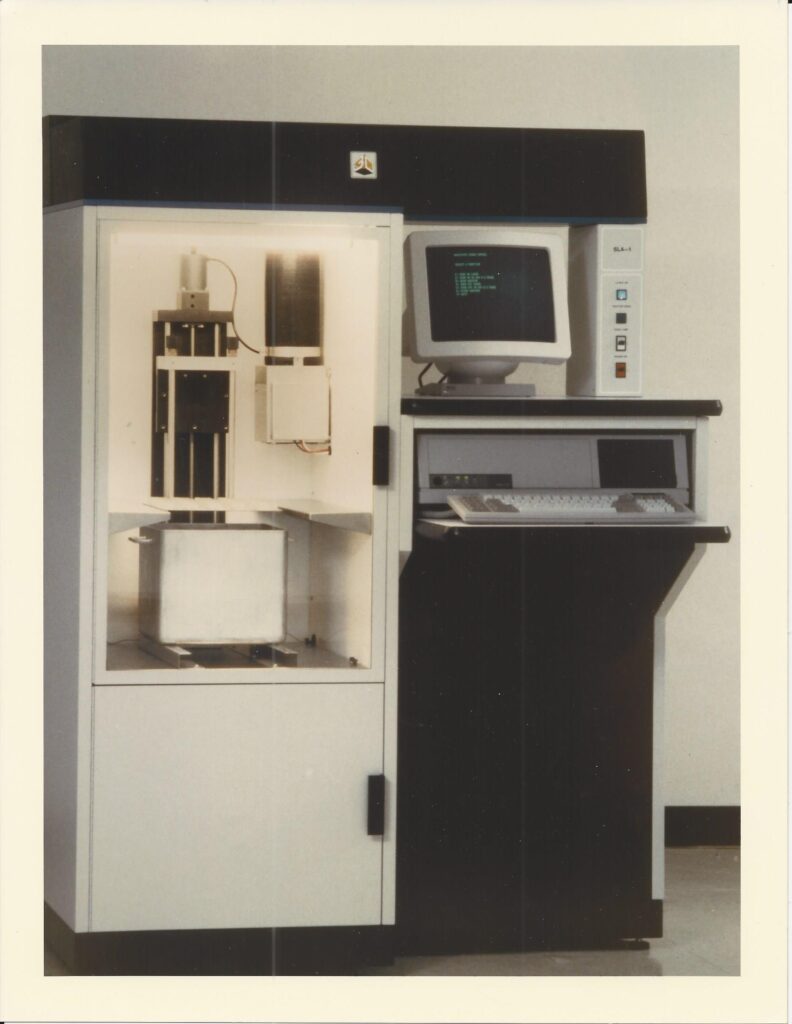I have had the pleasure of spending a good part of my career in 3D printing, mainly with technology vendors. Lately, the whole industry seems a bit down in the dumps. Public and private stock valuations are down. Startups are struggling to raise next rounds. Larger companies are restructuring. 3DPrint.com Executive Editor Joris Peels had a piece on this site declaring “3DP RIP 2023.”
My attempt in this article is to put some of this in perspective. For any business to be successful long term, it needs to solve a problem or fulfill a need for a customer at a price that the customer accepts, and around which the company can build a profitable business. If any of this is not true, the company will fail in the end. The firm may look like a bright shining star for a number of years, raising money, talking things up, but, ultimately, you need have something customers want and are willing to pay you enough for.

The 3D Systems SLA-1 Beta System at Pratt & Whitney, WPB, FL in 1987. Image courtesy of Jim Harrison.
3D printing was invented in the 1980s by Chuck Hull, Scott Crump, and a few others. Their new inventions were solving a real problem. Back then, making prototypes for design verification and testing was historically very slow and expensive. Having these magic machines available to get parts in a few hours or days was immensely valuable. However, early systems were expensive and only the big companies could have them.

MakerBot founders (left to right) Adam Mayer, Zach Smith and Bre Pettis with the final MakerBot Cupcake prototypes.
It took 20 years before Bre Pettis, hoisting a Makerbot on his shoulders on the cover of WIRED magazine, declared a significant disruption and the availability of this tool for the masses (at least the engineering and design masses). It took 20 years for rapid prototyping to transition from simply nice-to-have to table stakes. It took 20 years for the technologies to become easy enough to use and the price low enough for most engineers to be able to access. This first phase of the industry was solving a very big pain for engineers, and it became a standard way to work.
The last 15 years have been about moving this technology into manufacturing. Advances in processing power, materials, components, and costs have all made this possible for some applications. The use cases with the largest pain or the most attractive economics have been addressed first. For example, 3D printing is becoming a standard in dental. There are printed parts in commercial and military aircraft. There are printed orthopedic implants in thousands of patients. More will come.
So, what has been taking place more recently to cause a perceived market slowdown? Was there too much venture capital investment with short time horizons over the past 10 years? Were there IPOs pursued by companies that were not yet ready? Were there unrealistic adoption timeline expectations from basically everybody (including me)?
Yes, yes, and yes. But that doesn’t mean this is all for naught. It often takes an overshoot in investment to move industries forward. The dollars spent on machines, materials, parts, and applications is ten times what it was in 2010. Technological advancements are moving quickly. The question is now which companies involved can take all that has been achieved and build sustainable businesses. Some shareholders may lose, but the customers have so many more tools and options available to them now. If the customers win, an industry can become strong and valuable.
How often do you meet someone in your personal life that learns about what you do for a living only to respond, “That is so cool!” In the additive manufacturing industry, we are building technologies that will push production into the future. We are solving real problems in the medical device, transportation, electronics, and industrial markets. We get a front row seat to offering the picks and shovels for truly innovative product designers and manufacturing companies to come up with the next big things. We are playing a real role. We are doing important work.
Chin up.
John Kawola is the Chief Executive Officer-Global Operations of Boston Micro Fabrication (BMF). He has more than two decades of business leadership experience across the additive manufacturing, 3D printing and materials science industries. BMF is focused on introducing and scaling micro-3D printing technology to a range of industries that demand a high level of resolution and precision.
Subscribe to Our Email Newsletter
Stay up-to-date on all the latest news from the 3D printing industry and receive information and offers from third party vendors.
Print Services
Upload your 3D Models and get them printed quickly and efficiently.
You May Also Like
Making 3D Printing Personal: How Faraz Faruqi Is Rethinking Digital Design at MIT CSAIL
What if your 3D printer could think more like an intelligent assistant, able to reason through a design idea, ask questions, and deliver something that works exactly the way the...
Reinventing Reindustrialization: Why NAVWAR Project Manager Spencer Koroly Invented a Made-in-America 3D Printer
It has become virtually impossible to regularly follow additive manufacturing (AM) industry news and not stumble across the term “defense industrial base” (DIB), a concept encompassing all the many diverse...
Heating Up: 3D Systems’ Scott Green Discusses 3D Printing’s Potential in the Data Center Industry
The relentless rise of NVIDIA, the steadily increasing pledges of major private and public investments in national infrastructure projects around the world, and the general cultural obsession with AI have...
Formlabs Teams Up with DMG MORI in Japan
In late June, Nick Graham, Chief Revenue Officer at Formlabs, announced on LinkedIn that the company had partnered with DMG MORI, one of the world’s leading machine tool companies, to...


































